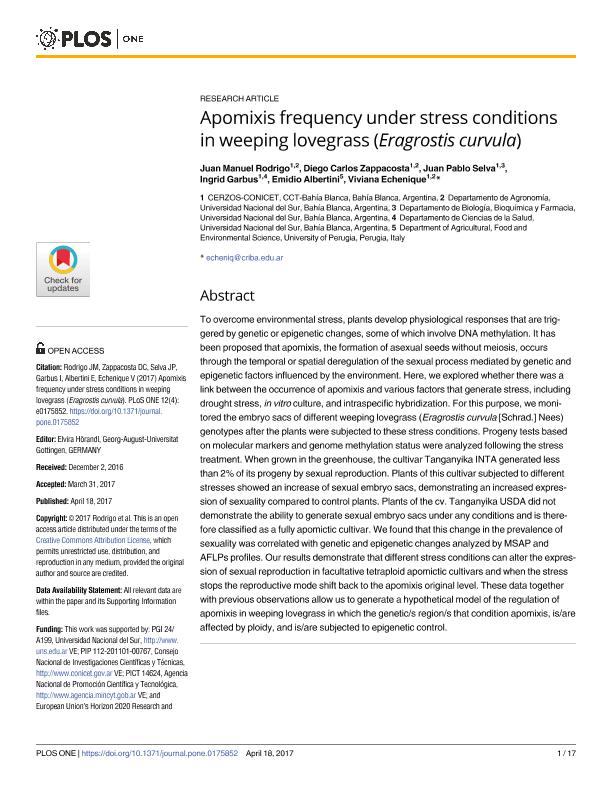Mostrar el registro sencillo del ítem
dc.contributor.author
Rodrigo, Juan Manuel

dc.contributor.author
Zappacosta, Diego Carlos

dc.contributor.author
Selva, Juan Pablo

dc.contributor.author
Garbus, Ingrid

dc.contributor.author
Albertini, Emidio
dc.contributor.author
Echenique, Carmen Viviana

dc.date.available
2017-09-26T20:10:46Z
dc.date.issued
2017-04
dc.identifier.citation
Rodrigo, Juan Manuel; Zappacosta, Diego Carlos; Selva, Juan Pablo; Garbus, Ingrid; Albertini, Emidio; et al.; Apomixis frequency under stress conditions in weeping lovegrass (Eragrostis curvula); Public Library of Science; Plos One; 12; 4; 4-2017; 1-17; e0175852
dc.identifier.issn
1932-6203
dc.identifier.uri
http://hdl.handle.net/11336/25166
dc.description.abstract
To overcome environmental stress, plants develop physiological responses that are triggered by genetic or epigenetic changes, some of which involve DNA methylation. It has been proposed that apomixis, the formation of asexual seeds without meiosis, occurs through the temporal or spatial deregulation of the sexual process mediated by genetic and epigenetic factors influenced by the environment. Here, we explored whether there was a link between the occurrence of apomixis and various factors that generate stress, including drought stress, in vitro culture, and intraspecific hybridization. For this purpose, we monitored the embryo sacs of different weeping lovegrass (Eragrostis curvula [Schrad.] Nees) genotypes after the plants were subjected to these stress conditions. Progeny tests based on molecular markers and genome methylation status were analyzed following the stress treatment. When grown in the greenhouse, the cultivar Tanganyika INTA generated less than 2% of its progeny by sexual reproduction. Plants of this cultivar subjected to different stresses showed an increase of sexual embryo sacs, demonstrating an increased expression of sexuality compared to control plants. Plants of the cv. Tanganyika USDA did not demonstrate the ability to generate sexual embryo sacs under any conditions and is therefore classified as a fully apomictic cultivar. We found that this change in the prevalence of sexuality was correlated with genetic and epigenetic changes analyzed by MSAP and AFLPs profiles. Our results demonstrate that different stress conditions can alter the expression of sexual reproduction in facultative tetraploid apomictic cultivars and when the stress stops the reproductive mode shift back to the apomixis original level. These data together with previous observations allow us to generate a hypothetical model of the regulation of apomixis in weeping lovegrass in which the genetic/s region/s that condition apomixis, is/are affected by ploidy, and is/are subjected to epigenetic control.
dc.format
application/pdf
dc.language.iso
eng
dc.publisher
Public Library of Science

dc.rights
info:eu-repo/semantics/openAccess
dc.rights.uri
https://creativecommons.org/licenses/by/2.5/ar/
dc.subject
Stress
dc.subject
Reproduction
dc.subject
Apomixis
dc.subject.classification
Ética relacionada con Biotecnología Agrícola

dc.subject.classification
Biotecnología Agropecuaria

dc.subject.classification
CIENCIAS AGRÍCOLAS

dc.title
Apomixis frequency under stress conditions in weeping lovegrass (Eragrostis curvula)
dc.type
info:eu-repo/semantics/article
dc.type
info:ar-repo/semantics/artículo
dc.type
info:eu-repo/semantics/publishedVersion
dc.date.updated
2017-09-19T14:41:57Z
dc.journal.volume
12
dc.journal.number
4
dc.journal.pagination
1-17; e0175852
dc.journal.pais
Estados Unidos

dc.journal.ciudad
San Francisco
dc.description.fil
Fil: Rodrigo, Juan Manuel. Consejo Nacional de Investigaciones Científicas y Técnicas. Centro Científico Tecnológico Conicet - Bahía Blanca. Centro de Recursos Naturales Renovables de la Zona Semiárida. Universidad Nacional del Sur. Centro de Recursos Naturales Renovables de la Zona Semiárida; Argentina
dc.description.fil
Fil: Zappacosta, Diego Carlos. Consejo Nacional de Investigaciones Científicas y Técnicas. Centro Científico Tecnológico Conicet - Bahía Blanca. Centro de Recursos Naturales Renovables de la Zona Semiárida. Universidad Nacional del Sur. Centro de Recursos Naturales Renovables de la Zona Semiárida; Argentina
dc.description.fil
Fil: Selva, Juan Pablo. Consejo Nacional de Investigaciones Científicas y Técnicas. Centro Científico Tecnológico Conicet - Bahía Blanca. Centro de Recursos Naturales Renovables de la Zona Semiárida. Universidad Nacional del Sur. Centro de Recursos Naturales Renovables de la Zona Semiárida; Argentina
dc.description.fil
Fil: Garbus, Ingrid. Consejo Nacional de Investigaciones Científicas y Técnicas. Centro Científico Tecnológico Conicet - Bahía Blanca. Centro de Recursos Naturales Renovables de la Zona Semiárida. Universidad Nacional del Sur. Centro de Recursos Naturales Renovables de la Zona Semiárida; Argentina
dc.description.fil
Fil: Albertini, Emidio. Università di Perugia; Italia
dc.description.fil
Fil: Echenique, Carmen Viviana. Consejo Nacional de Investigaciones Científicas y Técnicas. Centro Científico Tecnológico Conicet - Bahía Blanca. Centro de Recursos Naturales Renovables de la Zona Semiárida. Universidad Nacional del Sur. Centro de Recursos Naturales Renovables de la Zona Semiárida; Argentina
dc.journal.title
Plos One

dc.relation.alternativeid
info:eu-repo/semantics/altIdentifier/url/http://journals.plos.org/plosone/article?id=10.1371/journal.pone.0175852
dc.relation.alternativeid
info:eu-repo/semantics/altIdentifier/doi/http://dx.doi.org/10.1371/journal.pone.0175852
Archivos asociados
